Chapter: Compilers : Principles, Techniques, & Tools : Run-Time Environments
Stack Allocation of Space
Stack Allocation of Space
1 Activation Trees
2 Activation Records
3 Calling Sequences
4 Variable-Length Data on the
Stack
5 Exercises for Section 7.2
Almost all compilers for languages that use procedures, functions, or
methods as units of user-defined actions manage at least part of their run-time
memory as a stack. Each time a procedure1 is called, space for its local
variables is pushed onto a stack, and when the procedure terminates, that space
is popped off the stack. As we shall see, this arrangement not only allows space
to be shared by procedure calls whose durations do not overlap in time, but it
allows us to compile code for a procedure in such a way that the relative
addresses of its nonlocal variables are always the same, regardless of the
sequence of procedure calls.
1. Activation Trees
Stack allocation would not be feasible if procedure calls, or activations of pro-cedures, did not nest
in time. The following example illustrates nesting of procedure calls.
E x a m p l e 7 . 1 : Figure 7.2 contains a sketch of a program that
reads nine inte-gers into an array a
and sorts them using the recursive quicksort algorithm.
The main function has three tasks. It calls readArray, sets the sentinels, and then calls quicksort on the entire data array. Figure 7.3 suggests a sequence
of calls that might result from an execution of the program. In this execution,
the call to partition(l,9) returns 4,
so a[l] through a[3] hold elements
less than its chosen separator value v,
while the larger elements are in a [5] through a [9]. •
In this example, as is true in general, procedure activations are nested
in time. If an activation of procedure p
calls procedure q, then that
activation of q must end before the
activation of p can end. There are
three common cases:
1. The activation of q
terminates normally. Then in essentially any language, control resumes just
after the point of p at which the
call to q was made.
The activation of q, or some
procedure q called, either directly
or indi-rectly, aborts; i.e., it becomes impossible for execution to continue.
In that case, p ends simultaneously
with q.

3. The activation of q terminates because of an exception that q cannot han-dle. Procedure p may handle
the exception, in which case the activation of q has terminated while the activation of p continues, although not nec-essarily from the point at which the
call to q was made. If p cannot handle the exception, then this
activation of p terminates at the
same time as the activation of q, and
presumably the exception will be handled by some other open activation of a
procedure.
We
therefore can represent the activations of procedures during the running of an
entire program by a tree, called an activation tree. Each node corresponds to
one activation, and the root is the activation of the "main"
procedure that initiates execution of the program. At a node for an activation
of procedure p, the children correspond to activations of the procedures called
by this activation of p. We show these activations in the order that they are
called, from left to right. Notice that one child must finish before the
activation to its right can begin.
A Version of Quicksort
The sketch of a quicksort program in Fig. 7.2 uses two auxiliary
functions readArray and partition. The function readArray is used only to load the data into the array a. The first and last elements of a are not used for data, but rather for
"sentinels" set in the main function. We assume a[0] is set to a value lower than any possible data value, and
a[10] is set to a value higher than any data value.
The function partition divides
a portion of the array, delimited by the arguments m and n, so the low elements of a[m]
through a[n] are at the beginning,
and the high elements are at the end, although neither group is necessarily in
sorted order. We shall not go into the way partition
works, except that it may rely on the existence of the sentinels. One possible
algorithm for partition is suggested
by the more detailed code in Fig. 9.1.
Recursive procedure quicksort first decides
if it needs to
sort more than one element of the
array. Note that one element is always "sorted," so quicksort has
nothing to do in that case. If there are elements to sort, quicksort first
calls partition, which returns an index i to separate the low and high
elements. These two groups of elements are then sorted by two recursive calls
to quicksort.
E x a m p l e 7 . 2 : One possible activation tree that completes the
sequence of calls and returns suggested in Fig. 7.3 is shown in Fig. 7.4. Functions
are represented by the first letters of their names. Remember that this tree is
only one possibility, since the arguments of subsequent calls, and also the
number of calls along any branch is influenced by the values returned by partition. •
The use of a run-time stack is enabled by several useful relationships
between the activation tree and the behavior of the program:
The sequence of procedure calls
corresponds to a preorder traversal of the activation tree.
The sequence of returns
corresponds to a postorder traversal of the acti-vation tree.
Suppose that control lies within a particular activation of some
procedure, corresponding to a node N
of the activation tree. Then the activations that are currently open (live) are those that correspond to node
N and its ancestors. The order in
which these activations were called is the order in which they appear along the
path to N, starting at the root, and
they will return in the reverse of that order.
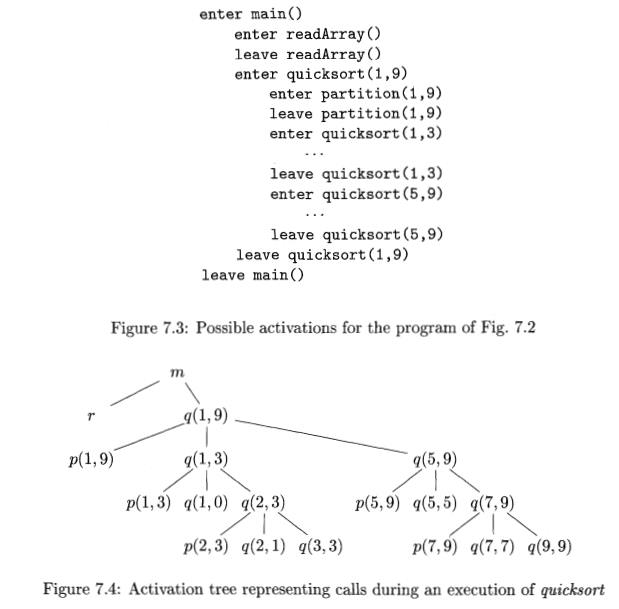
2. Activation Records
Procedure calls and returns are usually managed by a run-time stack
called the control stack. Each live
activation has an activation record (sometimes
called a frame) on the control stack,
with the root of the activation tree at the bottom, and the entire sequence of activation records on the stack
corresponding to the path in the activation tree to the activation where
control currently resides. The latter activation has its record at the top of
the stack.
Example 7 . 3 : If control is
currently in the activation 0(2,3) of the tree of Fig. 7.4, then the activation
record for q(2,3) is at the top of
the control stack. Just below is the activation record for 0(1,3), the parent
of 0(2,3) in the tree. Below that is the activation record 0(1,9), and at the
bottom is the activation record for m, the main function and root of the
activation tree.
We shall conventionally draw control stacks with the bottom of the stack
higher than the top, so the elements in an activation record that appear lowest
on the page are actually closest to the top of the stack.
The contents of activation records vary with the language being
imple-mented. Here is a list of the kinds of data that might appear in an
activation record (see Fig. 7.5 for a summary and possible order for these
elements):
Actual parameters
Returned values
Control link
Access link
Saved machine status
Local data
Temporaries
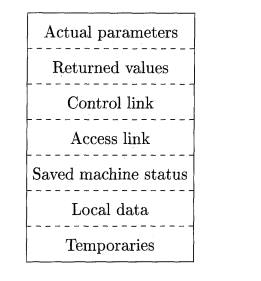
Figure 7.5: A general activation
record
Temporary values, such as those
arising from the evaluation of expres-sions, in cases where those temporaries
cannot be held in registers.
Local data belonging to the
procedure whose activation record this is.
A saved machine status, with
information about the state of the machine just before the call to the
procedure. This information typically includes the return address (value of the program counter, to which the called
procedure must return) and the contents of registers that were used by the
calling procedure and that must be restored when the return occurs.
An "access link" may be
needed to locate data needed by the called proce-dure but found elsewhere,
e.g., in another activation record. Access links are discussed in Section
7.3.5.
5. A control link, pointing to the activation record of the caller.
Space for the return value of the
called function, if any. Again, not all called procedures return a value, and
if one does, we may prefer to place that value in a register for efficiency.
The actual parameters used by the calling procedure. Commonly, these
values are not placed in the activation record but rather in registers, when
possible, for greater efficiency. However, we show a space for them to be
completely general.
Example 7.4 : Figure 7.6 shows snapshots of the run-time stack as
control flows through the activation tree of Fig. 7.4. Dashed lines in the
partial trees go to activations that have ended. Since array a is global, space
is allocated for it before execution begins with an activation of procedure
main, as shown in Fig. 7.6(a).

When control reaches the first call in the body of main, procedure r is activated, and its activation record is pushed
onto the stack (Fig. 7.6(b)). The activation record for r contains space for
local variable i. Recall that the top
of stack is at the bottom of diagrams. When control returns from this
activation, its record is popped, leaving just the record for main on the stack.
Control then reaches the call to q
(quicksort) with actual parameters 1 and 9, and an activation record for this
call is placed on the top of the stack, as in Fig. 7.6(c). The activation
record for q contains space for the
parameters m and n and the local variable i,
following the general layout in Fig. 7.5. Notice that space once used by the
call of r is reused on the stack. No trace of data local to r will be available
to q(l, 9). When q(l, 9) returns, the stack again has only the activation record for
main.
Several activations occur between the last two snapshots in Fig. 7.6. A
recursive call to g(l,3) was made. Activations p ( l , 3 ) and q(l,0) have
begun and ended during the lifetime of q(l, 3), leaving the activation record
for q(l, 3) on top (Fig. 7.6(d)). Notice that when a procedure is recursive, it
is normal to have several of its activation records on the stack at the same
time. •
3. Calling Sequences
Procedure calls are implemented by what are known as calling sequences, which consists of
code that allocates an activation record on the stack and enters information
into its fields. A return sequence is
similar code to restore the state of the machine so the calling procedure can
continue its execution after the call.
Calling sequences and the layout of activation records may differ
greatly, even among implementations of the same language. The code in a calling
se-quence is often divided between the calling procedure (the
"caller") and the procedure it calls (the "callee"). There
is no exact division of run-time tasks between caller and callee; the source
language, the target machine, and the op-erating system impose requirements
that may favor one solution over another. In general, if a procedure is called
from n different points, then the
portion of the calling sequence assigned to the caller is generated n times.
However, the portion assigned to the callee is generated only once. Hence, it
is desirable to put as much of the calling sequence into the callee as possible
— whatever the callee can be relied upon to know. We shall see, however, that
the callee cannot know everything.
When designing calling sequences and the layout of activation records,
the following principles are helpful:
1.
Values communicated between
caller and callee are generally placed at the beginning of the callee's
activation record, so they are as close as possible to the caller's activation
record. The motivation is that the caller can compute the values of the actual
parameters of the call and place them on top of its own activation record,
without having to create the entire activation record of the callee, or even to
know the layout of that record.
2.
Moreover, it
allows for the use of procedures
that do not always take the same
number or type
of arguments, such as C's p r i n t f function. The callee knows where to place the
return value, relative to its own activation record, while however many
arguments are present will appear sequentially below that place on the stack.
3.
Fixed-length items are generally
placed in the middle. From Fig. 7.5, such items typically include the control
link, the access link, and the machine status fields. If exactly the same
components of the machine status are saved for each call, then the same code
can do the saving and restoring for each. Moreover, if we standardize the
machine's status information, then programs such as debuggers will have an
easier time deciphering the stack contents if an error occurs.
Items whose size may not be known early enough are placed at the end of
the activation record. Most local variables have a fixed length, which can be
determined by the compiler by examining the type of the variable. However, some
local variables have a size that cannot be determined until the program
executes; the most common example is a dynamically sized array, where the value
of one of the callee's parameters determines the length of the array. Moreover,
the amount of space needed for tempo-raries usually depends on how successful
the code-generation phase is in keeping temporaries in registers. Thus, while
the space needed for tem-poraries is eventually known to the compiler, it may
not be known when the intermediate code is first generated.
4. We must locate the top-of-stack pointer judiciously. A common
approach is to have it point to the end of the fixed-length fields in the
activation record. Fixed-length data can then be accessed by fixed offsets,
known to the intermediate-code generator, relative to the top-of-stack pointer.
A consequence of this approach is that variable-length fields in the activation
records are actually "above" the top-of-stack. Their offsets need to
be calculated at run time, but they too can be accessed from the top-of-stack
pointer, by using a positive offset.
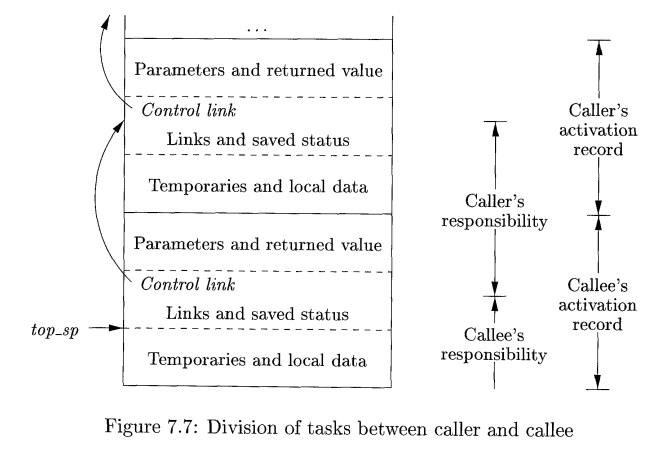
An example of how caller and callee might cooperate in managing the
stack is suggested by Fig. 7.7. A register topsp points to the end of the
machine-status field in the current top activation record. This position within
the callee's activation record is known to the caller, so the caller can be
made responsible for setting topsp
before control is passed to the callee.
The calling sequence and its division between caller and callee is as
follows:
1. The caller evaluates the
actual parameters.
The caller stores a return
address and the old value of topsp
into the callee's activation record. The caller then increments topsp to the po-sition shown in Fig.
7.7. That is, topsp is moved past the
caller's local data and temporaries and the callee's parameters and status
fields.
The callee saves the register
values and other status information.
The callee initializes its local
data and begins execution.
A suitable, corresponding return sequence is:
1. The callee places the return value next to the parameters, as in Fig.
7.5.
2. Using information in the machine-status field, the callee restores topsp and other registers, and then
branches to the return address that the caller placed in the status field.
3. Although topsp has been
decremented, the caller knows where the return value is, relative to the
current value of topsp; the caller
therefore may use that value.
The above calling and return sequences allow the number of arguments of the
called procedure to vary from call to call (e.g., as in C's p r i n t f
function). Note that at compile time, the target code of the caller knows the
number and types of arguments it is supplying to the callee. Hence the caller
knows the size of the parameter area. The target code of the callee, however,
must be prepared to handle other calls as well, so it waits until it is called
and then examines the parameter field. Using the organization of Fig. 7.7,
information describing the parameters must be placed next to the status field,
so the callee can find it. For example, in the p r i n t f function of C, the
first argument describes the remaining arguments, so once the first argument
has been located, the caller can find whatever other arguments there are.
4. Variable-Length
Data on the Stack
The run-time memory-management system must deal frequently with the
allo-cation of space for objects the sizes of which are not known at compile
time, but which are local to a procedure and thus may be allocated on the
stack. In modern languages, objects whose size cannot be determined at compile
time are allocated space in the heap, the storage structure that we discuss in
Section 7.4. However, it is also possible to allocate objects, arrays, or other
structures of unknown size on the stack, and we discuss here how to do so. The
reason to prefer placing objects on the stack if possible is that we avoid the
expense of garbage collecting their space. Note that the stack can be used only
for an object if it is local to a procedure and becomes inaccessible when the
procedure returns.
A common strategy for allocating variable-length arrays (i.e., arrays
whose size depends on the value of one or more parameters of the called
procedure) is shown in Fig. 7.8. The same scheme works for objects of any type if they are
local to the procedure called and have a size that depends on the
parameters of the call.
In Fig. 7.8, procedure p has
three local arrays, whose sizes we suppose cannot be determined at compile
time. The storage for these arrays is not part of the activation record for p,
although it does appear on the stack. Only a pointer to the beginning of each
array appears in the activation record itself. Thus, when p is executing, these pointers are at known offsets from the
top-of-stack pointer, so the target code can access array elements through
these pointers.
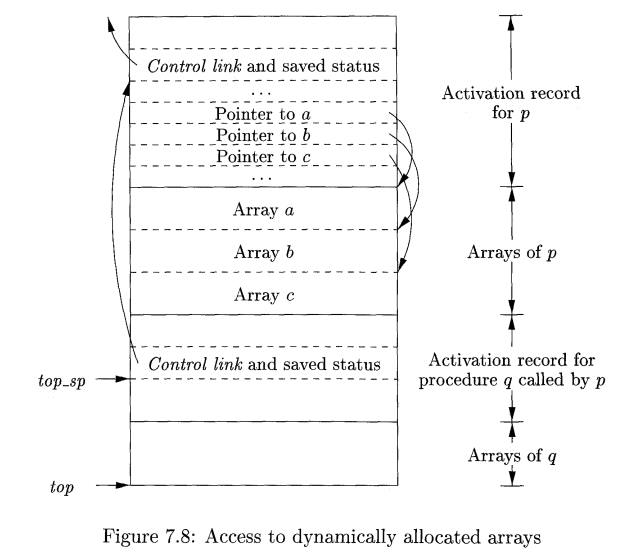
Also shown in Fig. 7.8 is the activation record for a procedure q,
called by p. The activation record for q begins after the arrays of p, and any
variable-length arrays of q are located beyond that . Access to the
data on the stack is through two pointers, top and topsp.
Here, top marks the actual
top of stack; it points to the position
at which the next activation record will begin. The second, topsp is used to find local, fixed-length
fields of the top activation record. For consistency with Fig. 7.7, we shall suppose that topsp points to the end of the machine-status
field. In Fig. 7.8,
topsp points to the end of this field in the activation record for q.
From there, we can find the control-link field for q, which leads us to the
place in the activation record for p where topsp pointed when p was on top.
The code to reposition top
and topsp can be generated at
compile time,
in terms of sizes that will become known at run time. When q returns, topsp can be restored from the saved control
link in the activation record for q.
The new value of top is (the old
unrestored value of) topsp minus the
length of the machine-status, control and access link, return-value, and
parameter fields (as in Fig. 7.5) in q's activation record. This length is
known at compile time to the caller, although it may depend on the caller, if
the number of parameters can vary across calls to q.
5. Exercises for Section 7.2
Exercise 7 . 2 . 1 : Suppose that the program of Fig. 7.2 uses a partition function that always picks a[m]
as the separator v. Also, when the
array a[m],... ,a[n] is reordered,
assume that the order is preserved as much as possible. That is, first come all
the elements less than v, in their
original order, then all elements equal to v,
and finally all elements greater than v,
in their original order.
Draw the activation tree when the
numbers 9 , 8 , 7 , 6 , 5 , 4 , 3 , 2 , 1 are sorted.
What is the largest number of
activation records that ever appear together on the stack?
Exercise 7 . 2 . 2: Repeat
Exercise 7.2.1 when the initial order of the numbers
is 1,3,5,7,9,2,4,6,8.
Exercise 7 . 2 . 3 : In Fig. 7.9 is C code to compute Fibonacci numbers recur-sively.
Suppose that the activation record for / includes the following elements in
order: (return value, argument n, local s,
local t); there will normally be
other elements in the activation record as well. The questions below assume
that the initial call is / ( 5 ) .
Show the complete activation
tree.
What does the stack and its
activation records look like the first time / ( l ) is about to return?
c) What does the stack and its
activation records look like the fifth time / ( l ) is about to return?
Exercise 7 . 2 . 4: Here is a
sketch of two C functions / and g:
int f(int x)
{ int i; ••• return i+1; ••• }
int g(int y)
{ int j; ••• f(j+D ••• 1
That is, function g calls /.
Draw the top of the stack, starting with the acti-vation record for g, after g calls /, and / is about to return. You can consider only return
values, parameters, control links, and space for local variables; you do not
have to consider stored state or temporary or local values not shown in the
code sketch. However, you should indicate:
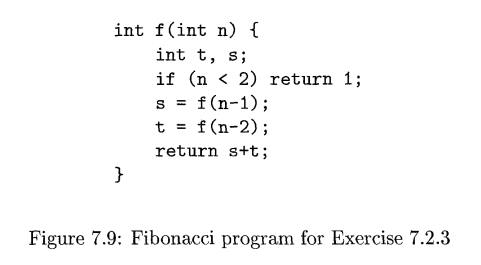
Which function creates the space
on the stack for each element?
Which function writes the value
of each element?
To which activation record does
the element belong?
Exercise 7.2.5 : In a language that passes parameters by reference,
there is a that does the function f(x,y) following:

If a is assigned the value 3,
and then f ( a , a) is called, what is returned?
Exercise 7 . 2 . 6 : The C
function f is defined by:

Variable a is a pointer to 6; variable 6 is a pointer to c, and c is an
integer currently with value 4. If we call f ( c , 6, a), what is returned?
Related Topics